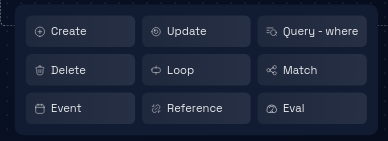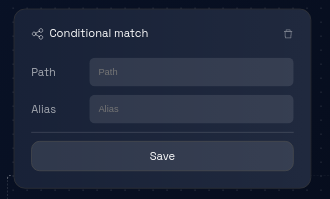Match
Step 1: Navigate to the Dataflow Page
Navigate to the Dataflow Page by following these steps.
Step 2: Locate the Dataflow Container
Identify the dataflow container that is connected to the event box with a purple border. This container represents the flow of data associated with the event.
Step 3: Add a Dataflow Pattern
Inside the identified dataflow container, find the "+" button. Clicking on this button will open a menu with options for adding a dataflow pattern. Click on the "+" button to open the menu.

Step 4: Select a Dataflow Pattern
In the menu that opens, you'll see a list of available dataflow patterns. Choose the appropriate dataflow pattern you want to add in this case Loop.

Step 5: Enter Edit Mode
By default, the dataflow pattern will be in preview mode. To make changes to the dataflow pattern, locate the "edit" icon, usually positioned at the header of the dataflow badge. Click on the "edit" icon to enter edit mode for the dataflow pattern.
Step 6: Configure Path and Alias
Inside the edit mode interface, configure the dataflow pattern:
Add Path Value: You can add the Path value, which might represent a specific path within the dataflow.
Assign Alias (Optional): Optionally, assign an alias value to the dataflow pattern for easier reference.

Step 7: Add Conditions and Cases
To add a condition and cases to the dataflow pattern, click on the "+" button within the edit mode interface. This action will open a menu. Click on "Add Case" in the menu to create a new condition and case.
Step 8: Write Condition
Inside the new case, write a condition within the provided input field. This condition determines when the associated dataflow pattern should be executed.
Step 9: Add Dataflow Pattern to Case
After writing the condition, click on the "+" button within the case to add the associated dataflow pattern.

Step 10: Add Default Case
To add a default case, click on "Add Default" within the menu. This case will be executed if none of the conditions match.
Add the dataflow pattern associated with the default case by clicking on the "+" button within the default case.
Step 11: Delete Dataflow Pattern (Condition or Default)
To delete a dataflow pattern associated with a condition or the default case, locate the "trash" icon associated with the pattern. This icon is typically positioned near the respective case. Click on the "trash" icon to delete the dataflow pattern.
Step 12: Save the Dataflow Pattern
After configuring paths, aliases, conditions, and cases, locate the "Save" button within the edit mode interface. Click on the "Save" button to apply the changes you've made to the dataflow pattern.
Step 13: Dataflow Pattern Update
The platform will process your changes and update the dataflow pattern according to your configurations.
The processing time may vary based on the complexity of the dataflow pattern and the platform's performance.
Step 14: Review and Continue
Review the data model to ensure that the dataflow pattern has been updated as per your configurations. You can proceed with other actions, such as editing other dataflow patterns, entities, or attributes.
Congratulations! You've successfully learned how to add and edit Match dataflow patterns.